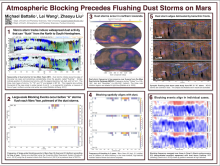Atmospheric Blocking Precedes Flushing Dust Storms on Mars
Michael
Battalio
Yale University
Poster
Mars provides the best studied atmosphere of any planet besides Earth, and as a result, exposes a new laboratory to refine our understanding of atmospheric dynamics. Twenty years of temperature retrievals from polar orbiters have prompted the development of multiple Martian atmospheric reanalysis datasets that enable the application of terrestrial dynamical diagnostics. Like Earth, Mars exhibits weather extremes—the most profound of which are semi-regular, regional to global dust events. Recently, the idea that the atmospheric blocking could explain one particular facet of dust event evolution has received attention. At the early stages of dust storm expansion, storms develop a comma-shaped morphology, as extratropical cyclones sweep dust into their cores. Extratropical waves traverse zonally confined storm tracks encircling the northern polar latitudes, but irregularly, dust lifted by the cyclones “flushes” from the northern to southern hemispheres through low-topography slopes without a clear impetus. Atmospheric blocking may halt the west-east wave progression to force dust southwards. Using the Ensemble Mars Atmospheric Reanalysis System (EMARS), we identify blocks in the northern hemisphere autumn storm season for one Mars Year using an blocking index applied to the mid-tropospheric zonal wind. We diagnose an association between multiple dust storm flushing events and the intensity of atmospheric blocking. This association suggests a widespread application of blocking diagnostics to all Mars reanalysis datasets and the expansion of the investigation between dust flushing and blocks.

Poster file
battalio_michael_blocking_poster.pdf
(12.42 MB)
Meeting homepage
